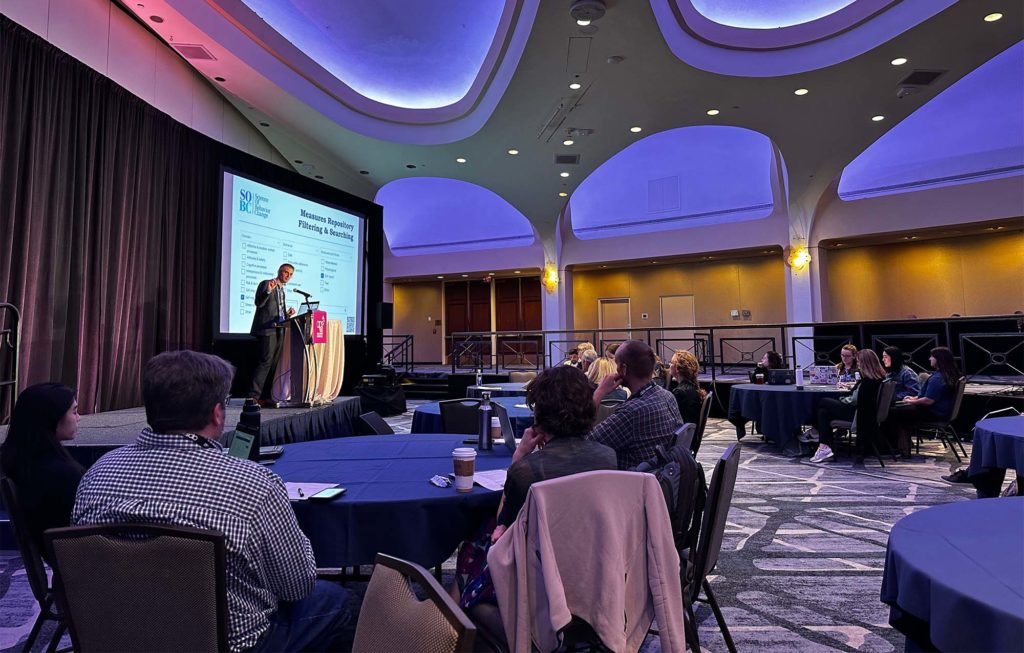APS Spotlight
Bringing Greater Rigor to Behavior-Change Research: NIH Best Practices

Image above: Jeffrey L. Birk, an instructor of medical sciences at Columbia University Medical Center, discussed the utility of the SOBC Measure Repository at the 2023 APS Annual Convention.
What is the long-term goal? What’s the objective? What’s the central hypothesis? What’s the rationale? In a workshop at the 2023 APS Annual Convention in May, researchers from the Science of Behavior Change Research Network discussed how adopting a framework that requires answering questions like these, simple as they may appear to be, can provide a critical advantage for researchers seeking to better understand and respond to the underlying mechanisms driving forms of behavior change.
For example, if the question of interest is how to manage the amount of time an adolescent plays computer games, the new framework suggests understanding this behavior as a surface feature of an underlying cause. It can be studied under addictive behavior, habit formation, or the need for building an online community. Addressing the behavior from multiple perspectives will help researchers develop a collection of measures they can use in their research program.
The Science of Behavior Change Research Network brings together researchers from the U.S. National Institutes of Health and a range of universities. APS is a partnering organization.
In the convention workshop, Jeffrey L. Birk, an instructor of medical sciences at Columbia University Medical Center, discussed the utility of the SOBC Measure Repository, where researchers can search for specific measures relevant to their research and can see the bidirectional nature of those measures. He also touched on the network’s future directions, including the development of ontologies in behavioral and social science research.
Melissa Riddle, director of the Behavioral and Social Sciences Research Program at NIH’s National Institute of Dental and Craniofacial Research, discussed the importance of employing the international quality standard of good clinical practice (GCP) in both general research as well as research for NIH-funded projects. Toward this end, she noted that NIH offers a Clinical Trial E-Protocol Tool with templates tailored specifically for behavioral science researchers. Additionally, each institute within NIH offers its own clinical toolkit to help researchers develop their own clinical protocols—for example, that of the National Institute of Mental Health.
Lisa Onken, who directs the Behavior Change and Intervention program in the Division of Behavioral and Social Research at NIH’s National Institute on Aging, discussed the synergies between the NIH Stage Model for Behavioral Intervention Development and the SOBC method, whose three steps are to identify, measure, and influence. The NIH Stage Model, she explained, aspires to be a cumulative science of intervention development based on a knowledge of mechanisms fostered by the experimental medicine approach. Its three key principles are potency, potentiating scalability, and personalization.
After the presentations, participants worked in small groups to get hands-on experience with the structure of the SOBC model. They were asked to imagine a research topic on behavior change and encouraged to motivate their research agenda by answering the four questions at the start of this article. Attendees learned that the targeted behavioral change cannot be thought of independently from the influence mechanism. Once a problem is identified (e.g., computer game addiction), it comes with possible solutions of behavior change (e.g., reduce the number of hours of computer game playing). But an intervention will only work when the influence mechanism is defined (e.g., addictive personality, stress release, channeling need for control, etc.).
Feedback on this article? Email [email protected] or login to comment. Interested in writing for us? Read our contributor guidelines.





APS regularly opens certain online articles for discussion on our website. Effective February 2021, you must be a logged-in APS member to post comments. By posting a comment, you agree to our Community Guidelines and the display of your profile information, including your name and affiliation. Any opinions, findings, conclusions, or recommendations present in article comments are those of the writers and do not necessarily reflect the views of APS or the article’s author. For more information, please see our Community Guidelines.
Please login with your APS account to comment.